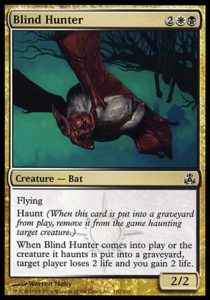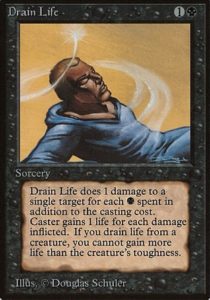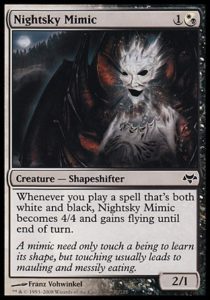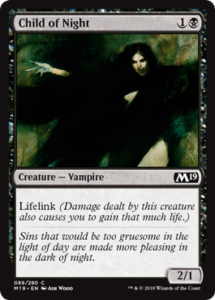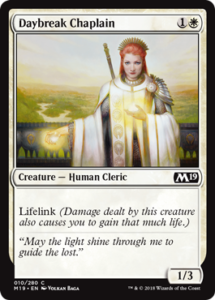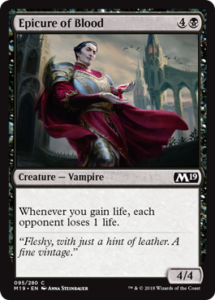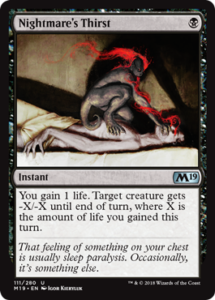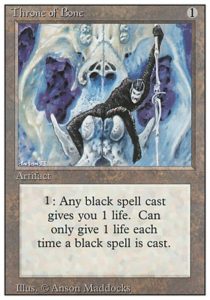Today, we’ve got some sweet spoilers for Magic 2019, which Wizards of the Coast has graciously shared with us. They showcase what a particular color pair is all about in M19, so let’s talk color pairs.
Every color pair has certain touchstones it regularly returns to. Blue-Red often rewards players for casting instants, sorceries, and artifacts. Green-Black tracks graveyards and counters. White-Red encourages going wide and attacking. Today, let’s talk about White-Black and how it cares about gaining life. And then let’s show off four M19 cards which play into the theme.
(If you wanna jump to the spoilers immediately, I feel you. They’re three sections down. If you see a card you’ve never seen before, you’ve probably reached your destination.)
The Origins of White/Black
White/Black rewarding lifegain might be a very familiar archetype, but that’s a relatively recent development. White/Black has only been spotlighted in three sets: Apocalypse, Guildpact, and Gatecrash (and a little bit in Khans of Tarkir). Enemy color pairs were intentionally underdeveloped for much of Magic’s history (to showcase that allies play better and more often together). 2012’s Innistrad began the era where most sets consistently have ten multicolor signpost uncommons, and that’s where white/black’s identity and mechanics really started being explored outside of the Orzhov Guild. But let’s go back to the very beginning: Alpha.
The Early Days of Draining and Gaining
Black and White have been gaining life since Alpha’s Drain Life and Healing Salve. Black stole life from enemies whereas white generated its from mana (green did the same in cards like Stream of Life). However, it took quite some time for the colors to combine forces.
Mirage and Visions introduced the first white/black cards (that weren’t also blue), but Circle of Despair, Purgatory (the first WB card to involve paying life), and Righteous War didn’t introduce a consistent theme to the color pair. WB gained another card in Tempest’s Selenia, Dark Angel, but it wasn’t until 2001’s Apocalypse (seven years after Alpha’s release) that white-black got its first widespread support. Death Grasp and Putrid Warrior were the first cards to both gain and drain life. Sure, lifegain wasn’t a theme, but Apocalypse provided the first glimmers of what would become perhaps the most consistent white/black theme. Scourge’s Edgewalker provided the first white-black tribal support (and spoilers, we’ve not seen much WB Cleric tribal support since), though we have seen WB tribal again in Khans of Tarkir’s warriors and Amonkhet’s zombies. Edgewalker was also the only white/black card released between 2001’s Apocalypse and 2006’s Guildpact.
The pieces of white/black were slowly coming together from 1993 to 2006. Today, WB is the color pair which bleeds opponents to death, usually a single point at a time. We saw the first half of this in Exodus’s Soul Warden, the other half in Mirrodin’s Disciple of the Vault, and both components combined in Champions of Kamigawa’s Thief of Hope. It was finally in Guildpact, the second time white/black was heavily featured, that this theme was incorporated into white and black concurrently. Cards like Agent of Masks, Blind Hunter, Ghost Council of Orzhova, Mourning Thrull, Orzhov Guildmage, and Pillory of the Sleepless all bled your opponent to death, draining one life point at a time (well, two in the case of Blind Hunter). There was no mechanic or reward for this other than the inherent benefit of draining life, but this was the real genesis of the color pair’s identity.
From Dissension to Today
Moving forward, Eventide introduced several white/black creatures with lifelink (a keyword which had only been introduced the previous year in Future Sight): Voracious Hatchling, Nip Gwyllion, Nightsky Mimic, and Divinity of Pride. Magic 2011 introduced Ajani’s Pridemade, the classic contemporary lifegain reward which would go on to be a powerful component of lifegain decks in Magic 2015 and Iconic Masters. Scars of Mirrodin and Innistrad introduced easy engines for taxing your opponents in Suture Priest, Falkenrath Noble, and Blood Artist. This all came to a head in Gatecrash, where Extort debuted as the first mechanic to specifically drain your opponents to death.
After Gatecrash, cards like Servant of Tymaret, Underworld Coinsmith, Scholar of Athreos, and Sentry of the Underworld played into the lifegain theme, either draining life or encouraging you use lifegain to offset a life payment. Battle for Zendikar was the first set to have an explicit lifegain mechanical theme without a keyword: Serene Steward and Cliffhaven Vampire formed the basis of the archetype, enabled by cards like Vampire Envoy and Stone Haven Medic.
From Battle for Zendikar to Ixalan, every block has had at least some nod to white/black draining life (Dominaria has repeatable life loss, but no W/B drain card). Pious Evangel, Campaign of Vengeance, Kambal, Consul of Allocation, and Wayward Servant all nodded to the theme. WB Vampires in Ixalan were explicitly based around this theme with lifelink and lifegain scattered across the two colors and cards like Famished Paladin and Glorifier of Dusk relying upon it to function.
And that brings us to today. We’ve seen heavy WB lifegain/drain themes in Ixalan, Iconic Masters, Battle for Zendikar, and Gatecrash, and mini-themes in most sets of the past six years. Come July, Magic 2019 will bring WB Lifegain back to the forefront. So, let’s see what it has for us!
A Familiar Face
Child of Night is back! It’s our first spoiler of four and the only reprint. It’s a simple, clean, and usually weak common that improves when there’s good equipment or if the format is defined by racing. It plays quite well with Cavalry Drillmaster (the 2/1 for 2 that gives a creature +2/+0 and first strike the turn it enters the battlefield).
Child of Day
Daybreak Chaplain is the white response to Child of Night. It’s not a particularly powerful card on its own, since 1/3s for 2 are rarely good (excepting in Dominaria where they all have upside). Still, if white/black is looking for repeatable sources of lifegain to enable cards like Cliffhaven Vampire, a 1/3 is much more likely to survive an attack or block than a 2/1. And, while Cliffhaven Vampire is on our minds…
“Fleshy, with just a hint of leather.”
Epicure of Blood is a Stone Golem with a drain engine built in. A 4/4 for five is rarely impressive or unplayable, but the five drop slot is an easier one to fill than most. The strength of Epicure of Blood really depends on whether there are easy repeatable lifegain enablers like Daggerdrome Imp or Soulmender (or if creatures are small enough that Stone Golem is decent).
At the time of writing, Skymarch Bloodletter and Lich’s Caress are two solid commons that have incidental lifegain (among many other cards that gain life). These cards don’t need any help from Epicure of Blood to be good. If there aren’t any repeatable lifegain enablers for Epicure of Blood, then the vampire is an expensive Extort creature that can only Extort with a fraction of your spells. That’s not awful, but it being a five drop means it comes down later on the curve than most of the cards which gain you life. So, the floor for this card is low. However, if there are easy repeatable methods of gaining life (even Ajani’s Mantra, given that there will presumably be more lifegain/drain payoffs), then Epicure of Blood could be a surprisingly decent win condition in a grindy deck, or a way to get in those last few points of damage.
The One Mana Kill Spell
Nightmare’s Thirst is the most powerful and last card we’ll reveal today. At worst, it’s Feast of Flesh and at its best, it’s a Swords to Plowshares where you gain a life.
Nightmare’s Thirst is difficult to utilize effectively. It isn’t a Doom Blade or even a Fatal Push—you need to build your deck to make this card function, but curving a Lich’s Caress into this is disgusting value. Moreover, there are plenty of easily obtained cards like Revitalize (the 1W instant that cantrips and gains you 3 life) or Dwarven Priest (the Conclave Phalanx for 3W without Convoke) that can turn on Nightmare’s Thirst. You won’t always want Nightmare’s Thirst in your Limited deck, but when half your deck incidentally gains you life, it’ll be one of your best cards.
Nightmare’s Thirst could even be Constructed viable. In an era where Goblin Chainwhirler decks apply pressure early and often, a one mana answer to a turn one Bomat Courier that nets a life which in the midgame can kill Hazoret, the Fervent is worth finding a home for. Heck, consider a heavy black control shell with Moment of Craving, Vraska’s Contempt, and Gifted Aetherborn—each of those cards turns Nightmare’s Thirst into an Ulcerate with upside, and an Aethersphere Harvester attack upgrades it into Grasp of Darkness. If the proper shell exists (or Llanowar Elves returns to the spotlight), Nightmare’s Thirst could be a major boon for black. Time will tell.
It’s interesting that white/black’s theme in Magic 2019 is lifegain. Sure, there’s ample precedent (as stated by much of this article), but lifegain is something new players tend to overvalue and ]need to break the habit of if they want to improve. Having lifegain as a theme encourages new players to develop potentially bad habits, overvaluing lifegain for longer than they would otherwise. And this is a good thing. Spikey newer players will enjoy learning this lesson and everyone else simply gets to enjoy doing what new players tend to enjoy doing: gaining life. It’s good for an introductory product to lean into what new players enjoy, rather than focus it energies teaching them intermediate play patterns.
And that’s all for this week. Hopefully you’re enjoying Magic 2019 spoiler season—it certainly was an enormous privilege to spoil four cards from it. Huge thanks again to Wizards of the Coast for providing us with them, and best of luck to everyone on July 7-8 for M19 prerelease weekend.
And, as always, thanks for reading!
—Zachary Barash
Zachary Barash is a New York City-based game designer. He works for Kingdom Death: Monster, has a Game Design MFA from the NYU Game Center, and does freelance game design. When the stars align, he streams Magic.
His favorite card of the month is Goblin Fireslinger. It’s brutally simple and quite weak but it just plays perfectly with Bloodthirst (which it was designed to do). And it can be surprisingly potent clock when games go long. It pulls a whole lot of work for a simple common.

